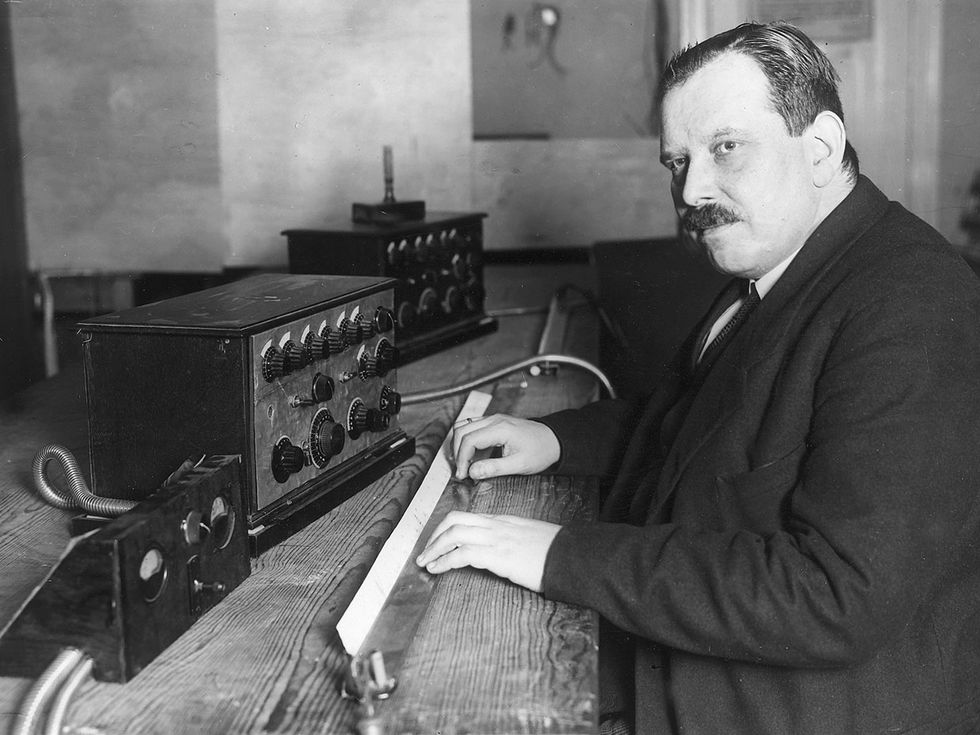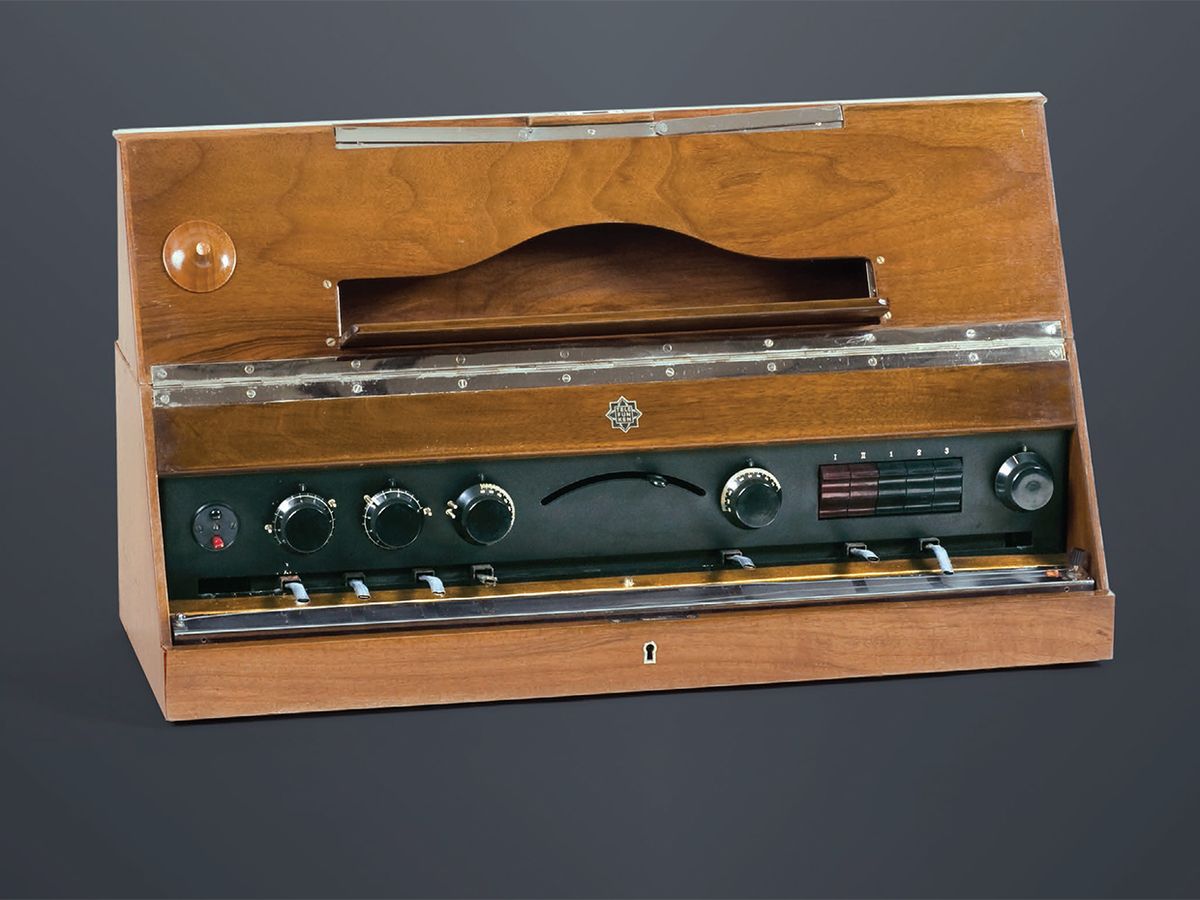I knew next to nothing about electronic music when I began researching this month’s column. My only association with the genre was the synthesizer sounds of ’80s pop and the (for me) headache-inducing beats of EDM. I never stopped to think about the roots of electronic music, and so I was surprised to learn that it can be traced back more than a century. It also has more than a passing association with the Nazis. Frode Weium, senior curator at the Norwegian Museum of Science and Technology, is the person who nominated the Volkstrautonium for this month’s Past Forward artifact and sent me down this fascinating musical rabbit hole.
The Volkstrautonium arose during the wave of electronic music that began shortly after World War I. Inventors in Europe, the Soviet Union, and the United States were creating a cacophony (or, if you like, a symphony) of new electronic musical instruments. It’s hard to say exactly why electronic music took off as it did, but the results were diverse and abundant. Some of the new creations took the name of their inventor, such as the theremin (for León Theremin) and the Ondes Martenot (for Maurice Martenot). Others were portmanteaus that merged musical and electronic terms: the Terpiston, the Rhythmicon, the Cathodic Harmonium, the Radiophonic Organ, the Magnetophone, the Spherophone, the Elektrochord.
The music theorist Jörg Mager welcomed these new sounds. Often considered the founder of the electro-music movement, Mager in 1924 published his essay “Eine neue Epoche der Musik durch Radio” (“A New Epoch in Music Through Radio”), in which he argued that the radio was not simply a tool to disseminate sound, but also a tool to manipulate sound waves and create a new form of music.
In this burgeoning world of sonic experimentation, Germany was the epicenter. And an electrical engineer and trained musician named Friedrich Trautwein wanted a piece of the action. Trautwein had trained at the Heidelberg Conservatory and then studied engineering and acoustics at Karlsruhe Technical University, receiving his doctorate in 1921. He filed his first patent for electric tone generation a year later.

Trautwein’s first attempt at a new musical instrument was the Trautonium, an electrified cross between a violin (a violin with only one string, that is) and a piano (minus the keyboard). The playing interface, or manual, of the Trautonium consisted of a single wire stretched over a metal plate. When the musician pressed the wire against the plate, it closed the circuit and produced a tone. Moving your finger along the wire from left to right changed the resistance and therefore the pitch, while knobs on the console further adjusted the pitch. A set of movable keys let the musician set fixed pitches. It sounded like a violin. Sort of.
The original Trautonium generated its sound using tubes filled with neon gas, which functioned as a relaxation oscillator. The neon tubes were later replaced with a type of high-energy gas tube called a thyratron, which helped stabilize the pitch.
Trautwein continued to experiment with ways of manipulating the electronic tone to produce the most pleasing timbre, according to Thomas Patteson, a professor of music history at the Curtis Institute of Music, in Philadelphia, who has done significant research on the history of the Trautonium. (For an extended description of Trautwein’s formant theory, for instance, see Chapter 5 of Patteson’s book Instruments for New Music: Sound, Technology, and Modernism, University of California Press, 2015.)
In 1930 Trautwein became a lecturer in acoustics at the Berlin Academy of Music, where he met Paul Hindemith, who was teaching music composition there. Almost immediately, the two began to collaborate on improving the Trautonium. Hindemith, already an established composer, wrote music specifically for the instrument and encouraged others to play it. One of Hindemith’s students, Oskar Sala, became a virtuoso on the instrument.
In this 1930 recording, Sala plays an early Trautononium:
Sala, like Trautwein, had dual interests in music and science; he went on to study physics at what is now Humboldt University of Berlin.
The Trautonium debuted to the public on 20 June 1930 as part of a summer concert series devoted to new music. For the performance, Hindemith composed Das kleinen Elektromuskiers Lieblinge (The Little Electro-musician’s Favorites), a set of seven short pieces for a trio of Trautonia. Hindemith, Sala, and the pianist Rudolf Schmidt performed the pieces and demonstrated the potential range of the new instrument. In conjunction with the performance, Trautwein published a short book, Elektrische Musik, that served as a technical guide to the Trautonium.
The following year, Hindemith conducted his Concertino for Trautonium and String Orchestra at the second Radio Music Convention, in Munich, with Sala as the soloist. And at the 1932 Radio Exhibition, in Berlin, the Trautonium was part of the “electric orchestra,” which also featured an electric cello, electric violin, electric piano, and theremin.
Trautwein and Sala believed that the Trautonium had commercial appeal beyond the concert hall. Beginning in 1931, they partnered with the electronics firm Telefunken to create a mass-marketable instrument. The result was the Telefunken-Trautonium, which later became known as the Volkstrautonium.
Because the Volkstrautonium was intended for use in the home, it underwent a few design changes from Trautwein’s original machine. The manual and circuitry were consolidated into a single box with a cover to minimize dust. Additional knobs and switches helped the player control the sound. The instrument could be plugged into a radio receiver for amplification.
Despite all these enhancements, the Volkstrautonium did not make a splash when it debuted at the 1933 Radio Exhibition. Of the 200 or so that were produced, only a few were ever sold.
The instrument may have been a victim of particularly poor timing. Priced at 400 reichsmarks, or about two and a half months’ salary for the average German worker, it would have been a significant investment. Meanwhile, amidst a global economic depression, unemployment in Germany hovered around 30 percent. The Volkstrautonium was simply unaffordable for most people.
Telefunken’s lackluster marketing of the instrument, which included almost no advertising, didn’t help matters. The company officially stopped making them in 1937, and all unsold units were given to Trautwein.
According to Frode Weium, the Volkstrautonium pictured at top was a gift from AEG Berlin, which partially owned Telefunken, to Alf Scott-Hansen Jr., a Norwegian electrical engineer, amateur jazz musician, and film director. It’s unclear whether Scott-Hansen used this Volkstrautonium. The Norwegian Museum of Science and Technology acquired it in 1995.
Though the Volkstrautonium was not a commercial success, that didn’t stop the Trautonium from finding a niche audience among radio enthusiasts. Despite the high price of the Volkstrautonium, it had a fairly simple design. You could build a pared-down version with easily available parts. In March 1933, Radio-Craft magazine published detailed instructions on how to build a Trautonium [PDF], slightly altered for U.S. customers with parts available in the United States.
According to the Radio-Craft article, the Trautonium was not just easy to build but also easy to play: “One may learn to play it in a short time, even though one is not a musician.” Perhaps that was true, but playing well was probably another matter.
Finding music to play on the Trautonium would also have been tricky. In order to popularize any new instrument, you need new music to be written for it. Otherwise, the instrument only mimics other instruments—there’s no signature sound or essential need that allows the new instrument to take root. The theremin, for example, didn’t pass into obscurity like many of the other instruments of the early electro-music age because its uniquely eerie sound became popular in scores for science fiction and horror movies. [The theremin also inspires occasional reboots, a few of which are described in "The Return of the Theremin" and "How to Build a Theremin You Can Play With Your Whole Body," in IEEE Spectrum.]
The Trautonium, for its part, produced a surprising range of sound effects for Alfred Hitchcock’s 1963 horror-thriller The Birds, a movie famous for its lack of a traditional score. Instead, Oskar Sala created the screeches and cries of the birds, as well as the slamming of doors and windows, using a variation of Trautwein’s instrument that he designed:
Sala scored hundreds of films with his Trautonium, refining the instrument throughout his life. He never trained any students to play it, however, nor did other composers besides Hindemith produce melodic smash hits with the instrument. It thus fell into obscurity.
More recently, a few artists have rediscovered the range and potential of the Trautonium. The Danish musician Agnes Obel played a replica Trautonium on her 2016 album Citizen of Glass. The German musician Peter Pichler wrote a music theater piece, Wiedersehen in Trautonien (Reunion in Trautonia), which is an account of an imagined meeting of Trautwein, Hindemith, and Sala. He also took his Trautonium on tour in Australia last April.
I said there were Nazis, and here they are: Like all German academics, Trautwein had to navigate the difficult political climate of the 1930s and ’40s. Like many, he joined the Nazi Party, was rewarded with a promotion to professor, and rode out the war years mostly unscathed.
In 1935 Trautwein and Sala presented a Trautonium to Joseph Goebbels, Hitler’s minister of propaganda. Goebbels was, unsurprisingly, mostly interested in the propaganda value of music. Luckily for Trautwein, electro-music fit into the Reich’s desire to reconcile technology and culture. Trautwein volunteered the Trautonium to test the speaker system for the 1936 Olympic Games in Berlin, and it was played three times in official radio programs accompanying the games.
Hindemith, who was married to a Jewish woman and who often collaborated with leftists, didn’t fare as well under the Nazis. Goebbels pressured him to take an extended leave of absence from the Berlin Academy, and he found it increasingly difficult to perform and conduct. His work was banned in 1936. Hindemith and his wife immigrated to Switzerland two years later, settled in the United States in 1940, and returned to Europe in 1953.
When I first listened to the 1930 recording of Oskar Sala playing Trautwein’s simple electronic instrument, I was struck by how the sound seems both strange and familiar. Now that I know the history of the Trautonium and its champions, I think the word that best describes it is haunting.
An abridged version of this article appears in the October 2019 print issue as “An Instrument for The Birds.”
Part of a continuing serieslooking at photographs of historical artifacts that embrace the boundless potential of technology.
About the Author
Allison Marsh is an associate professor of history at the University of South Carolina and codirector of the university’s Ann Johnson Institute for Science, Technology & Society. She dedicates this month’s column to her uncle Ralph Morrison, who died in August. “Ralph was an IEEE Life Member and also an avid violinist,” Marsh says. “I am pretty sure he would have hated the music the Trautonium produced, but I know he would have loved discussing the electrical and acoustical challenges of the instrument.”
